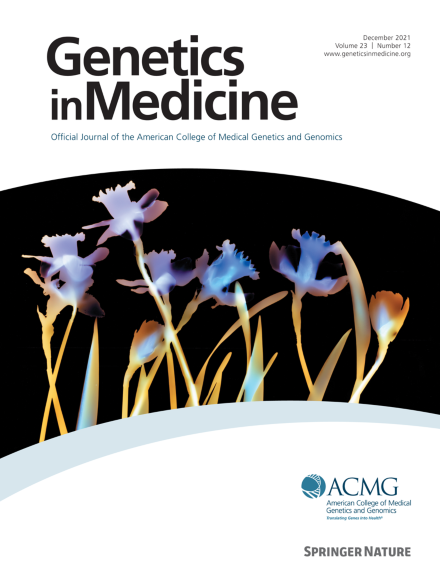新生儿筛查与永久性听力损失相关的常见遗传变异:安大略省的实施和前3年的回顾
IF 6.6
1区 医学
Q1 GENETICS & HEREDITY
引用次数: 0
摘要
目的:通用新生儿听力筛查(UNHS)项目仅使用听力测量技术检测非先天性儿童永久性听力损失(PHL)的能力有限。2019年,安大略省启动了PHL危险因素的新生儿普遍筛查(NBS):先天性巨细胞病毒(cCMV)和GJB2和SLC26A4的22种常见变体。在这里,我们描述我们的经验,遗传风险因素筛选。方法:对参加UNHS的安大略省新生儿进行常规新生儿筛查采集的干血点进行危险因素筛查。通过定制MassArray检测进行筛选,并通过Sanger测序或PCR确认阳性。对所有筛查阳性婴儿进行诊断性听力学评估。结果:筛选了412,424名婴儿,其中93名有GJB2或SLC26A4两种变体。其中72例确诊为PHL, 20例听力正常,1例拒绝随访。13名婴儿患有PHL (1 / 31,724;(11.8%的筛查阳性)没有通过听力测试确定,因为他们通过(3)或错过(10)筛查。重要的是,在最终接受人工耳蜗植入的婴儿中,通过NBS检测遗传病因可以加快诊断、评估和干预的时间。结论:遗传筛查加强了安大略省PHL患儿的UNHS和护理。这项研究是朝着在NBS中更广泛地纳入基因组检测迈出的一步。本文章由计算机程序翻译,如有差异,请以英文原文为准。
Newborn screening for common genetic variants associated with permanent hearing loss: Implementation in Ontario and review of the first 3 years
Purpose
Early hearing detection and intervention (EHDI) programs using audiometric screening techniques alone have a limited ability to detect noncongenital childhood permanent hearing loss (PHL). In 2019, Ontario launched universal newborn screening (NBS) for PHL risk factors, including congenital cytomegalovirus and 22 common variants in GJB2 and SLC26A4. Here, we describe our experience in screening for genetic risk factors.
Methods
Ontario newborns who participated in universal newborn hearing screening (UNHS) were offered risk factor screening using dried blood spots (DBS) collected for conventional newborn screening. The screening was conducted using a custom MassArray assay, and positive results were confirmed by Sanger sequencing or polymerase chain reaction. Diagnostic audiological assessments were performed for all screen-positive infants.
Results
Of the 412,424 infants screened, 93 had 2 variants in GJB2 or SLC26A4. Of these, 72 had confirmed PHL, 20 had normal hearing, and 1 declined follow-up. Thirteen infants with PHL (1 in 31,724; 11.8% of screen positives) were not identified through audiometric testing as they passed (3) or missed (10) the screening. Importantly, among infants who ultimately received cochlear implants, the detection of genetic etiology through NBS led to an accelerated time to diagnosis, assessment, and intervention.
Conclusion
Genetic screening has strengthened UNHS and care for infants with or at risk of PHL in Ontario. This study is a step toward the broader inclusion of genomic testing in NBS.
求助全文
通过发布文献求助,成功后即可免费获取论文全文。
去求助
来源期刊

Genetics in Medicine
医学-遗传学
CiteScore
15.20
自引率
6.80%
发文量
857
审稿时长
1.3 weeks
期刊介绍:
Genetics in Medicine (GIM) is the official journal of the American College of Medical Genetics and Genomics. The journal''s mission is to enhance the knowledge, understanding, and practice of medical genetics and genomics through publications in clinical and laboratory genetics and genomics, including ethical, legal, and social issues as well as public health.
GIM encourages research that combats racism, includes diverse populations and is written by authors from diverse and underrepresented backgrounds.
 求助内容:
求助内容: 应助结果提醒方式:
应助结果提醒方式:


